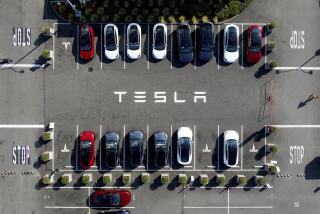Glut makes newer used cars more affordable
- Share via
With the average new vehicle selling for more than $26,000, more than what many first-time buyers can afford, a late-model used car that costs half that can be a sensible alternative.
New-vehicle sales have occurred at record or near-record levels the last four years, resulting in a glut of used cars from trade-ins. That glut and rampant discounting of new models are depressing used-car values.
The average used-vehicle transaction price declined slightly last year to $13,841 from $13,930 the year before, according to the National Automobile Dealers Assn.
New-car bargains continue to abound, thanks to no-interest financing and $3,000 rebates on vehicles that sell for less than $20,000.
Despite such offers, Consumer Reports magazine steers first-time buyers toward used cars, especially “certified” used models with factory warranties.
“Young buyers are usually on a limited budget, so they should want to avoid paying all that depreciation that comes in the first two years when it’s always the highest,” said Rob Gentile, manager of Consumer Reports’ new- and used-car price service.
Buying a used car carries more risks, but Gentile said certified vehicles are inspected, repaired and guaranteed by the manufacturers.
Edmunds.com, a site that carries automotive information and new- and used-car ads, estimates that a $20,000 new car will cost more than $32,000 to own over five years, including payments, depreciation and expenses such as maintenance, insurance and state registration fees. A $10,000 used car will cost about $18,000 to own over five years, Edmunds said.
Philip Reed, consumer advice editor for Edmunds, said some new cars lose 20% to 30% of their value in the first year, an expense borne by the initial owner. He also recommends manufacturer-certified used vehicles, some of which come with roadside assistance in case of a breakdown, the same as a new model. “Peace of mind is really a big thing with buyers, but cars have never been so reliable as they are now,” Reed said. “With some of the certified programs, used cars are 95% as good as a new car.”
Among the advantages of buying new is the availability of interest-free financing, a perk not available on used cars. Interest rates on used cars tend to be at least one point higher than the rates for new vehicles.
Gentile and Reed point out that it takes a blue-chip credit record to qualify for no-interest financing. Many first-time buyers aren’t eligible simply because they don’t have a long enough credit history.
“A lot of people think they automatically qualify for zero percent, but there are many who have been buying cars for years who don’t,” Gentile said, suggesting that buyers not base their decision on securing no-interest financing. “If you don’t qualify, all of a sudden you’re back to square one.”
Instead of the financing offer, consumers can take the rebate and use it as their down payment. Lenders usually require at least 10% down for a new-car loan.
New-car invoice prices are readily available and incentive programs are widely publicized. Reed said establishing a realistic price for a used vehicle is “a little trickier” because mileage, equipment and the vehicle’s overall condition affect value.
Several Web sites provide used-car values, among them Edmunds, Kelley Blue Book (www.kbb.com), the National Automobile Dealers Assn. (www.nadaguides.com) and Cars.com, an affiliation of several newspapers.






